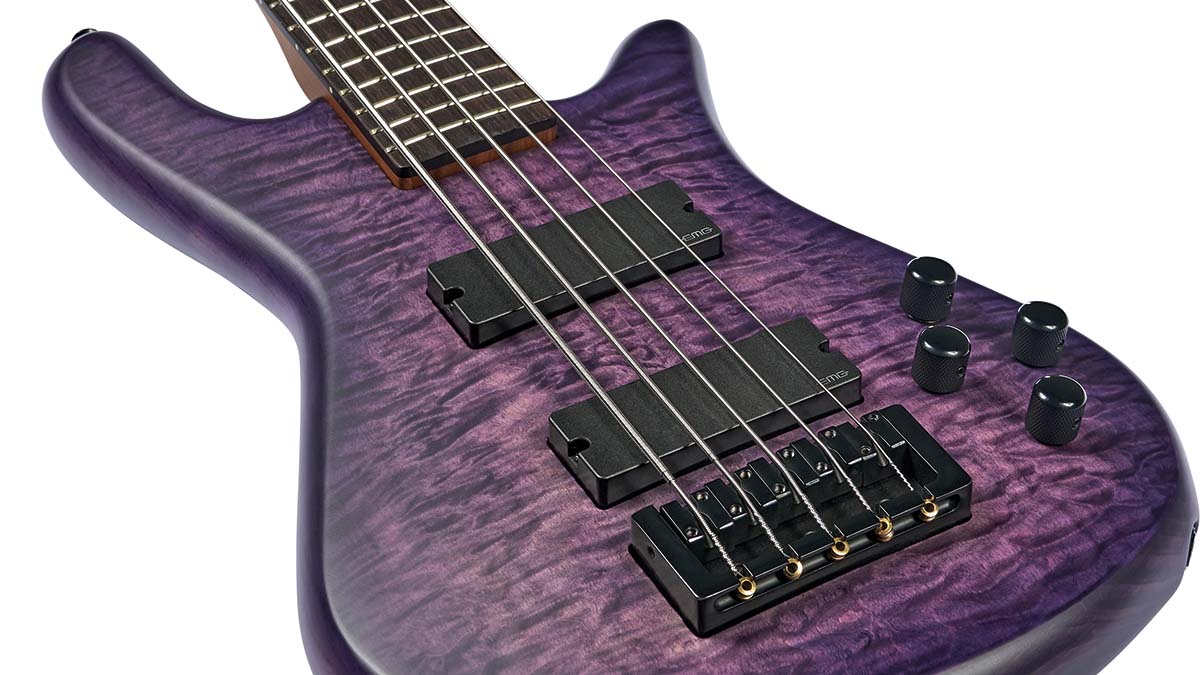Guitar World Verdict
The NS Pulse II is a potent and exceedingly well-crafted instrument that more than justifies its midrange price tag. We recommend it.
Pros
- +
Sturdy construction.
- +
Powerful pickups.
Cons
- -
Two-channel preamp requires more precision than a three-band EQ.
You can trust Guitar World
Spector’s first bass guitar, the NS-1, made its earthly debut in March 1977, and two years later, the NS-2 arrived.
Over the ensuing decades, the classic NS design has withstood any need for enhancement: Its sleek, ergonomically-efficient shape has proven immensely popular among players looking to harness the power and versatility of the OG model both on stage and in the studio.
From Guy Pratt’s addictive bassline on Madonna’s Like A Prayer via Scott Smith’s timeless grooves with Loverboy, to Bob Rock’s thundering rhythms on Metallica’s St. Anger album, the NS continues to cast a long shadow across modern music.
In late 2020, Spector introduced the NS Pulse range, which featured two eye-popping, sandblasted designs along with premium electronics. This year, they ratchet this model a notch higher with the release of the NS Pulse II – an impressive-looking instrument that seeks to deliver an array of improvements on its predecessor.
Build Quality
Since the ’80s, Spector has set up international production sites across the globe, with its factories in South Korea handling production of the NS Pulse II. Straight out of the box, the bass strikes an enviable balance between sturdy construction and a light, portable weight. Whereas the original Pulse model showcased this swamp ash body, the Pulse II adds a quilted maple top, along with a three-piece roasted maple bolt-on neck.

The dark, Macassar ebony fretboard commands attention with 24 medium frets, a custom Spector mother-of-pearl inlay on the twelfth fret and illuminating side dots. We receive a five-string for evaluation, which boasts a 35” scale (the four-string is 34”) which is handy when tuning down. Additionally, there’s a locking bridge, smooth black die-cast tuners and a graphite nut.
The electronics vary between the four- and five-string models; the former features an EMG P/J pickup set, while our review model packs a pair of EMG 40DC humbuckers. Running along the bottom contour are two volume knobs and a two-band EQ for bass and treble boost, which drive Spector’s proprietary Tone Pump Jr. preamp.
All the latest guitar news, interviews, lessons, reviews, deals and more, direct to your inbox!
While the original Pulse models showcased a grainy finish, the Pulse II offers a more elegant look, with a smooth matte finish that’s available in three luxurious colors: Black Cherry, Black Stain, and Ultra-Violet.
Sounds and Playability
There’s much to love with the three-dimensionally sculpted contours of the Pulse II. It rests neatly on the lap and proves exceedingly comfortable and well-balanced with a strap. Navigating the neck is as easy as any we’ve played, with its well-spaced frets and an ultra-smooth fingerboard.
With the neck joined to the body way down at the 19th fret, there’s easy access all the way through the second octave. As a bolt-on, the neck doesn’t deliver the same degree of sustain as a neck-through, but with an instrument like this, you’re looking for a bit more punch – and that’s precisely what you’ll find.

One persisting quibble with the original Pulse model involved the Tone Pump Jr active preamp, with reports that it tended to leak low noise, especially with a bit of treble boost. This is not the case with the Pulse II; played through both Ampeg and Orange amps, the instrument remains noise-free at rest.
It has a liquid low-end and a spacious dynamic range that any jazz, blues, or gospel player would instantly covet
The 40DC humbuckers allow us to boldly explore the considerable dynamic range that the five-string delivers, with some glassy, slap-friendly highs and obnoxiously fat lows that punch like a heavyweight.
Playing from the bridge pickup, we go full bore on both volume knobs with the preamp fully cut, and the result is a round tone that approaches P-bass territory. Boosting the bass halfway uncorks a tasty low-end growl – and with the bass fully boosted, our dogs retreat upstairs at the first rumble of furniture.
The midrange serves up a pleasant bite and we’re able to conjure a broad spectrum of tones without losing definition. Cutting the bass all the way back and bringing in some treble creates a bright, snappy tone that, while not as sharp as we expected, would cut easily through any mix. From the neck pickup, we coax a warm, jazzy tone with the bass halfway boosted and a dash of treble.
Running through a number of styles, we don’t come close to tapping into the full tonal prowess of the Pulse II. Although it proves more than equal to the task with virtually any rock or metal that we play, the Pulse II is by no means a headbanger-only instrument.
It has a liquid low-end and a spacious dynamic range that any jazz, blues, or gospel player would instantly covet. More than anything, the Pulse II is addictively fun to play.
Specs
- PRICE: $1399 / £1,190
- MADE IN: South Korea
- BODY: Swamp ash with quilted maple top
- NECK: Three-piece roasted maple, illuminated side dots, graphite nut, 35” scale (34” scale on four-string)
- NECK: Bolt-on
- FINGERBOARD: Macassar ebony, 24 frets
- PICKUPS: 2 x active EMG 40DC humbuckers (P/J pickups on four-string)
- ELECTRONICS: Spector TonePump Jr preamp
- HARDWARE: Locking bridge, die-cast tuners
- WEIGHT: 9.7 lbs
- LEFT-HAND AVAILABLE: No
- CASE/GIG-BAG INCLUDED: No
- CONTACT: Spector

